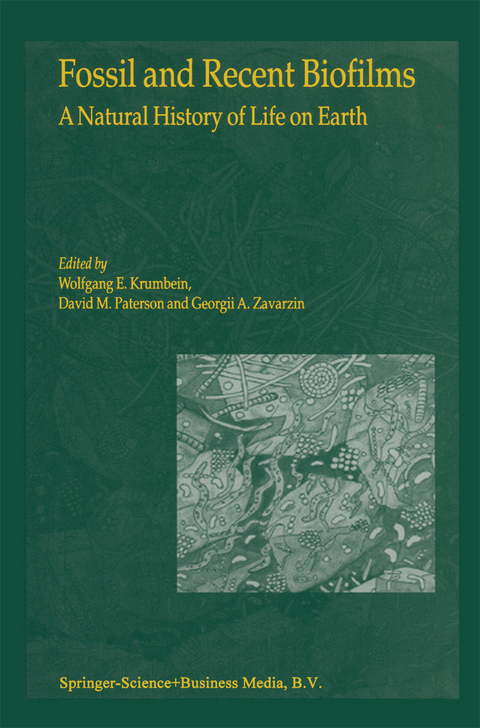
Fossil and Recent Biofilms
Springer (Verlag)
978-90-481-6412-7 (ISBN)
Biodata of the Editors. Acknowledgements. Preface. Microbial biofilms: protective niches in ancient and modern geomicrobiology; J.W. Costerton, P. Stoodley. 1: Biofilm, Biodictyon Biomat - Microbialites, Oolites, Stromatolites - Geophysiology, Global Mechanism, Parahistology; W.E. Krumbein, U. Brehm, A.A. Gorbushina, G. Levit, K.A. Palinska. 2: Development and architecture of complex environmental biofilms - lotic biofilm systems; T.R. Neu, A. Eitner, M. Luz Paj. 3: Ecosystem function, cell micro-cycling and the structure of transient biofilms; D.M. Paterson, R. Perkins, M. Consalvey, G.J.C. Underwood. 4: Structure of marine biofilms - Flat Laminated Mats and Modern Marine Stromatolites; J.F. Stolz. 5: Growth, structure and calcification potential of an artificial cyanobacterial mat; M. Kühl, T. Fenchel, J. Kazmierczak. 6: Microbial processes forming marine stromatolites - Microbe-Mineral Interactions with a Three-Billion-Year Rock Record; P. Reid, C.D. Dupraz, P.T. Visscher, D.Y. Sumner. 7: Nitrogen cycling in marine cyanobacterial mats; L.J. Stal. 8: Diversity of Cyano-Bacterial Mats; G.A. Zavarzin. 9: Microbial spheres from microbial mats; U. Brehm, W.E. Krumbein, K.A. Palinska. 10: Protozoans and biofilms; H. Arndt, K. Schmidt-Denter, B. Auer, M. Weiterer. 11: Bryozoan morphoprocesses; J. Scholz, G. Levit. 12: Biofilms and macroorganisms; G. Gerdes. 13: 'Farming' of microbial mats in the hindgut of echinoids; C. DeRidder, R.L. Brigmon. 14: Extracellular polymers (EPS) and calcification within modern marine stromatolites; A.W.Decho, T. Kawaguchi. 15: The Study of a recent Iron-encrusted biofilm in the marine environment; D.C. Gillan. 16: Microbial endoliths as internal biofilms; S. Golubic, J. Schneider. 17: Epibenthic cyanobacterial communities interacting withsedimentary processes in siliciclastic depositional systems (present and past); N. Noffke. 18: The role of biofilms in the fossilization of non-biomineralized tissues; D.E.G. Briggs. 19: Fossil and subrecent fungal communities in three calcrete series from the devonian of the Canadian rocky mountains, Carboniferous of northern France and Cretaceous of central Italy; A. Preat, K. Kolo, B. Mamet, A.A. Gorbushina, D.C. Gillan. 20: Archean biofilms preserved in the Swaziland supergroup, South Africa; M. M. Walsh, F. Westall. 21: Is the feedback between genetic structure and community structure the computational mechanism of biofilm evolution? D.E. Caldwell. 22: Is there an adequate terminology of biofilms and microbial mats? G. Levit, W.E. Krumbein. 23: Hidden in plain sight - A macroscopic approach to biofilms and other visible manifestations of bacteria in the teaching of field microbiology; B.D. Dyer. 24: Is it possible to quantitatively assess the role of algobacterial films in a water body? N.V. Shadrin. 25: The role of fungal biofilm and networks in the terrestrial calcium carbonate cycle; E.P. Verrecchia, C. Loisy, O. Braissant, A.A. Gorbushina. 26: Past and present biofilm formation in deep fennoscandian shield groundwater; K. Pedersen. 27: Melanin and chromatic changes in black crusts of sandstone monuments; J.M. Valero, J.I. AlavaAlava.
| Erscheint lt. Verlag | 1.12.2010 |
|---|---|
| Zusatzinfo | XXI, 482 p. |
| Verlagsort | Dordrecht |
| Sprache | englisch |
| Maße | 155 x 235 mm |
| Themenwelt | Naturwissenschaften ► Biologie ► Biochemie |
| Naturwissenschaften ► Biologie ► Limnologie / Meeresbiologie | |
| Naturwissenschaften ► Biologie ► Mikrobiologie / Immunologie | |
| Naturwissenschaften ► Biologie ► Ökologie / Naturschutz | |
| Naturwissenschaften ► Biologie ► Zoologie | |
| Naturwissenschaften ► Geowissenschaften ► Geografie / Kartografie | |
| Naturwissenschaften ► Geowissenschaften ► Mineralogie / Paläontologie | |
| ISBN-10 | 90-481-6412-5 / 9048164125 |
| ISBN-13 | 978-90-481-6412-7 / 9789048164127 |
| Zustand | Neuware |
| Haben Sie eine Frage zum Produkt? |
aus dem Bereich


